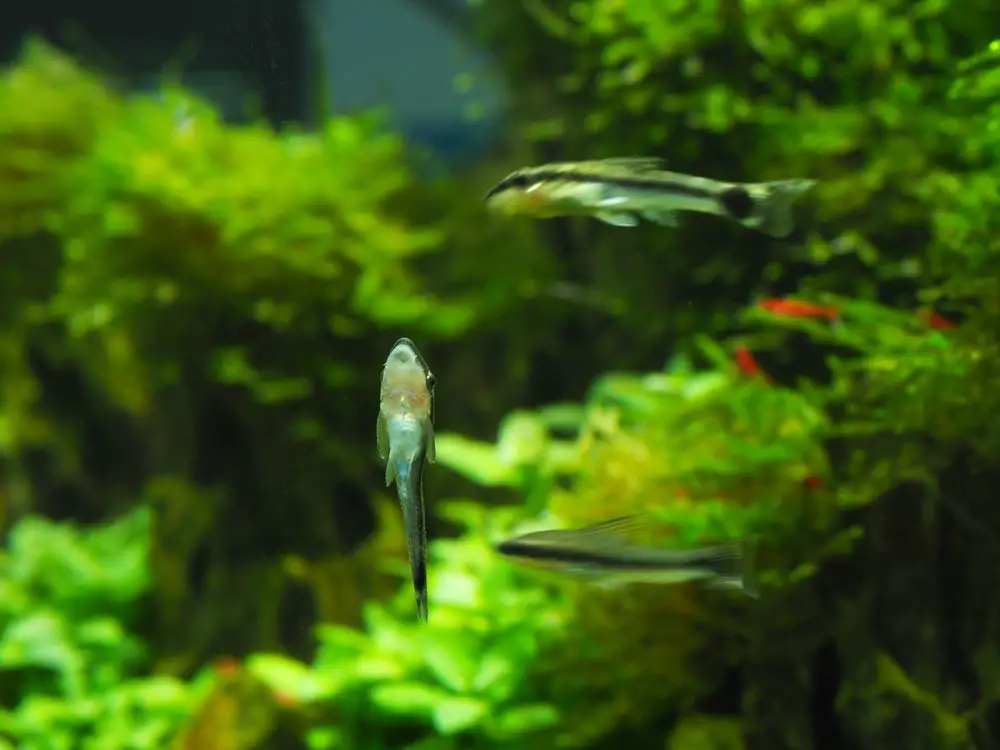Otocinclus Catfish are Not 100% Shrimp Safe.
Hey, shrimpfam! I’ve been breeding shrimp and Otos together for over 15 years and keeping aquariums for 40+ years and let me tell you, the waters are murky regarding this topic. I’ve seen firsthand that Otos can and will snack on baby shrimp if given the chance.
I also used to condition my female Otos with live bloodworm and brine shrimp, and if they can eat those, they can eat baby shrimp.
Now, I get it. You’ve never seen your Otos eat shrimp, but consider this baby shrimp are about 2mm in size—pretty easy to miss, right? I’ve kept them together successfully, but it’s crucial to know that Otos are opportunistic regarding food.
Otocinclus Catfish: The Shrimp Safety Debate
Otos have a diverse diet, and yes, they can consider baby shrimp as a potential snack. I’ve conditioned my Otos with live bloodworm and brine shrimp, which has expanded their dietary range.
This means that even if you’ve never seen your Otos munching on shrimp, those tiny 2mm baby shrimp could be at risk. It’s essential to understand that Otos are opportunistic feeders, and when it comes to food, they can be quite versatile.

The Dynamics of Tank Coexistence
Sharing a tank is not just about cohabitation it’s about creating a balanced ecosystem where each species can thrive. Otos are primarily algae grazers, often too engrossed in their biofilm buffet to even notice your shrimp.
But nature is unpredictable. If a baby shrimp happens to cross an Oto’s path during its foraging, it might not hesitate to make a meal of it. The key to successful coexistence lies in understanding the behavioral patterns of both species.
Otos are generally peaceful but can become opportunistic when food is scarce like most animals. Therefore, monitoring their behavior is crucial, especially during feeding times.

Otocinclus Diet: What’s on the Menu?
While Otos are algae lovers, they are not strict vegetarians. They have a varied diet that includes algae, biofilm, and, occasionally, protein-rich foods.
This is an important consideration because what Otos eat directly impacts the safety of your shrimp. Adult shrimp usually don’t face any risks due to their size and agility, but baby shrimp could be at risk. Baby shrimp are not as fast or as agile as their adult counterparts, making them an easier target for Otos that are looking for a quick snack.

The Vulnerability of Baby Shrimp
Baby shrimp are especially vulnerable due to their small size and lack of experience in evading predators. Their size, just 2mm, makes them an easy target for any fish that doesn’t mind a little protein in their diet.
Otos that have been conditioned to eat protein-rich foods like bloodworms or brine shrimp pose an even greater risk to these tiny crustaceans.
The risk is not just theoretical; it’s based on years of observation and experience. If you’re planning to breed shrimp, it’s crucial to consider this and plan your tank setup accordingly.
Strategies for Risk Mitigation
Reducing the risk of Otos eating your baby shrimp involves a multi-faceted approach. First, consider the layout of your tank. Create distinct zones using aquatic plants, driftwood, and specialized shrimp hides.
These serve as both grazing surfaces for Otos and safe havens for shrimp. Second, diet plays a crucial role. Regularly feeding your Otos with algae wafers or blanched vegetables like zucchini and spinach can keep them satiated, reducing the likelihood of them considering alternative food options.
Lastly, maintaining stable water parameters is essential for the well-being of both species. Regular water changes, proper filtration, and water quality monitoring can go a long way in ensuring a peaceful coexistence.

Additional Tips for a Harmonious Tank
Beyond the basics, there are additional steps you can take to ensure a harmonious tank environment. Consider adding more vertical spaces like tall plants or rock formations. These can act as additional barriers and hiding spots, further reducing risks. Also, consider the social dynamics of your tank.
Otos are social fish and prefer to be in groups, which can sometimes reduce their interest in exploring other food options. Similarly, shrimp are more comfortable and less stressed when they have plenty of hiding spots, which makes them less likely to venture into risky areas.
The Final Verdict on Otos and Shrimp
In summary, while Otocinclus catfish and shrimp can technically share a tank, it’s not without its challenges. Otos are opportunistic when it comes to their diet, and baby shrimp are particularly vulnerable.
However, with meticulous planning, a well-designed tank, and a deep understanding of each species’ dietary and behavioral traits, you can create a balanced and harmonious environment.
If you have further questions or need additional insights, feel free to reach out. I also actively participate in the Aquarium Shrimp Keeping Facebook group , Just make a new post, and I or one of my moderators will see it.
, Just make a new post, and I or one of my moderators will see it.
Happy Shrimp and Oto Keeping! 🦐
